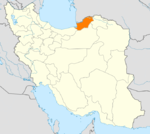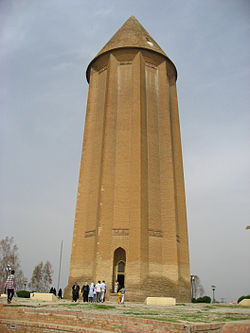- Gonbad-e Qabus
-
For the administrative subdivision, see Gonbad-e-Qabus County.
Gonbad-e Qabus
گنبد كاووس— City — The tower is a remnant of Ziyarid architecture. Coordinates: 37°15′00″N 55°10′02″E / 37.25°N 55.16722°ECoordinates: 37°15′00″N 55°10′02″E / 37.25°N 55.16722°E Country  Iran
IranProvince Golestān Province County Gonbad-e-Qabus Bakhsh Central Population (2006) – Total 127,167 Time zone IRST (UTC+3:30) – Summer (DST) IRDT (UTC+4:30) Gonbad-e Qabus at GEOnet Names Server Gonbad-e Qābus[1] (Persian: گنبد قابوس) or Gonbad-e Kāvus (Persian: گنبد كاووس); formerly Dashte Gorgan)[2] is a city in and the capital of Gonbad-e-Qabus County, in the province of Golestān in the northeast of Iran. At the 2006 census, its population was 127,167, in 30,710 families.[3]
The population is predominantly Turkmens.
The city is famous for a historic brick tower by the same name.
Contents
The Tower
The Tower in the central part of the city reaches 72 metres (236 ft)[4] (including the height of the platform), however, it is not the tallest brick tower in the world (after many towers). However,it is still the tallest pure-brick tower in the world.[4]
The baked-brick-built tower is an enormous decagon building with a conic roof, which forms the golden ratio that Phi equals 1.618. The interiors contain the earliest examples of Muqarnas decorative styles. The decagon with its 3 meter-thick wall, divided into 10 sides, has a diameter of 17 m . The Tower was built on such a scientific and architectural design that at the front of the Tower, at an external circle, one can hear one's echo.
The tower was built in 1006 AD on the orders of the Ziyarid Amir Shams ol-Ma'āli Qabus ibn Wushmgir (شمس المعالي قابوس بن وشمگير).It is located 3 km north of the ancient city of Jorjan, from where the Ziyarid dynasty ruled. The tower is over 1000 years old.
A Kufic inscription at the bottom of the tower reads in Arabic:
هذا القصر العالي – لامير شمس المعالي – الامير قابوس ابن وشمگير – امر به بنائه في حياته – سنه سبع و تسعين – و ثلثمائه قمريه و سنه خمس و سبعين و ثلثمائه شمسيه
- "This tall palace for the prince Shams ul-Ma'ali, Amir Qabus ibn Wushmgir ordered to build during his life, in the year 397 the lunar Hegira , and the year 375 the solar Hegira"
Even though the inscription does not explicitly refer to the rumor that the tower was built for the tomb for the prince Ziyarid ruler, it is believed that the Sultan's body was put in a glass coffin and was suspended from the ceiling of the tower.
Iran plans to submit the tower to UNESCO for registration as a World Heritage Site, for the tower's upcoming 1,000th anniversary.
Gonbad-e Qābus or Gonbad-e Kāvus (also transcribed Gonbad-e Ghābus or Gonbad-i Ghāboos) is a city in the province of Golestan in Iran. The city tower was built with bricks representing a special art related to the 4th century(Hegira, or 11th century). This tower which stands on a domed hill with 15 m height is located in the central (principal) park of Gonbad Kavoos city.
Robert Byron, the British travel writer and architectural critic, wrote that it was a photograph of the tower that motivated him to visit Persia.[5] Seeing the tower, he maintained his high opinion of its qualities, writing in The Road to Oxiana, that 'the Gumbad-i-Kambus ranks with the great buildings of the world.'[6]
Historical attractions
See also: Great Wall of GorganQizil Alan's Defense Wall (155 km long and 6 to 10 meter wide) is one of the most outstanding and gigantic architectural monuments in Gorgan Plain (Turkoman sahra steppes) history. This wall, which is the largest defensive wall in the world after the Great Wall of China, starts from the Caspian sea coast, circles north of Gonbade Kavous, continues towards the northwest, and vanishes behind the Pishkamar Mountains. A logistical archaeological survey was conducted regarding the wall in 1999 due to problems in development projects, especially during construction of the Golestan Dam, which irrigates all the areas covered by the wall. At the point of the connection of the wall and the drainage canal from the dam, architects discovered the remains of the above wall. At parts, this wall is 6m wide and in other parts the width is 10m, which proves that the thickness of the wall differs in various regions, according to the natural features and soil types. Castles have been built at different distances. The longest distance between castles is 50 km and the shortest is 10 km. The 40 identified castles vary in dimension and shape but the majority are square fortresses. Due to many difficulties in development and agricultural projects, archaeologists have been assigned to mark the boundary of the historical find by laying cement blocks. The Qizil Alan's Wall has been named Alexander Dam, Anushirvân Dam, Firuz Dam and Gorgan's Defense Wall in various historical texts. Those who are originally from Gorgan, are a little bit prejudice in favor of calling the wall Gorgan's Defense Wall. Dr. Kiani who led the archeological team in 1971 believes that the wall was built during the Parthian dynasty simultaneously with the construction of the Great Wall of China and it was restored during the Sassanid era (3-7th c. AD).
Natural attractions
- Golestan Forest
- chehelchay Forest
- Alma gol lake
- Ala gol lake
- Aji gol Lake
- Gonbad Horse Racing Center
Colleges and universities
- Payamnoor University of Gonbad[website http://gpnu.ac.ir]
- Islamic Azad University of Gonbad
- College of Agriculture in Gonbad
See also
References
- ^ The city's name is also Romanized as Gonbad-e Ghābus, Gonbad-i Ghāboos, Gonbadekavoos, Gonbad-e Kāvūs, Gonbad Qābūs, Gonbad Qavoos, Gunbad-i-Kāwās, Gunbad-i-Kāwūs, and Gunbad-i-Qābūs.
- ^ Gonbad-e Qabus can be found at GEOnet Names Server, at this link, by opening the Advanced Search box, entering "-3064799" in the "Unique Feature Id" form, and clicking on "Search Database".
- ^ "Census of the Islamic Republic of Iran, 1385 (2006)" (Excel). Islamic Republic of Iran. http://www.amar.org.ir/DesktopModules/FTPManager/upload/upload2360/newjkh/newjkh/27.xls.
- ^ a b SkyscraperPage - Gonbad-e Qabus Tower
- ^ Bryon, Robert The Road to Oxiana, P.161, Pimlico, 2004
- ^ Bryon, Robert; The Road to Oxiana, P.166, Pimlico, 2004
External links
Architecture of Iran Styles Parsi style · (includes Pre-Parsi style and Achaemenid architecture)
Parthian style · (includes Sassanid architecture)
Khorasani style · Razi style · Azari style · Isfahani style
Elements Notable traditional cities Architecture of Tehran · Bam · Bukhara · Ctesiphon · Derbent · Herat · Isfahan · Kashan · Merv · Mashhad · · Nishapur · Persepolis · Qazvin · Qom · Samarkand · Shahrisabz · Shiraz · Susa · Tabriz · Takht-i-Suleiman · Yazd · Gur-e AmirTheory and Analysis Lists  Golestan Province
Golestan ProvinceCapital 
Counties and Cities Aliabad-e Katul · FazelabadAqqala · AnbaralumBandar-e Gaz · Now KandehGonbad-e-Qabus CountyGonbad-e Qabus · Incheh BorunGorgan · Sarkhon KalatehKalaleh CountyKalalehMinudasht · GalikashTorkaman CountySights Alma gol lake · Alangdareh · Ashuradeh · Great Wall of Gorgan · Golestan National Park · Gonbad-e Qabus Tower · ShirAbad Waterfall · Kaboud-val · Naharkhoran · Gomishan lake · Voshmgir dam · Miankaleh peninsula · Makhtum Quli Farghi's mausoleum · Radkan DomeCategories:- Gonbad-e-Qabus County
- Cities in Iran
- Towers in Iran
- Iranian architecture
- 1000s architecture
- Cities in Golestan Province
- Persian words and phrases
Wikimedia Foundation. 2010.


